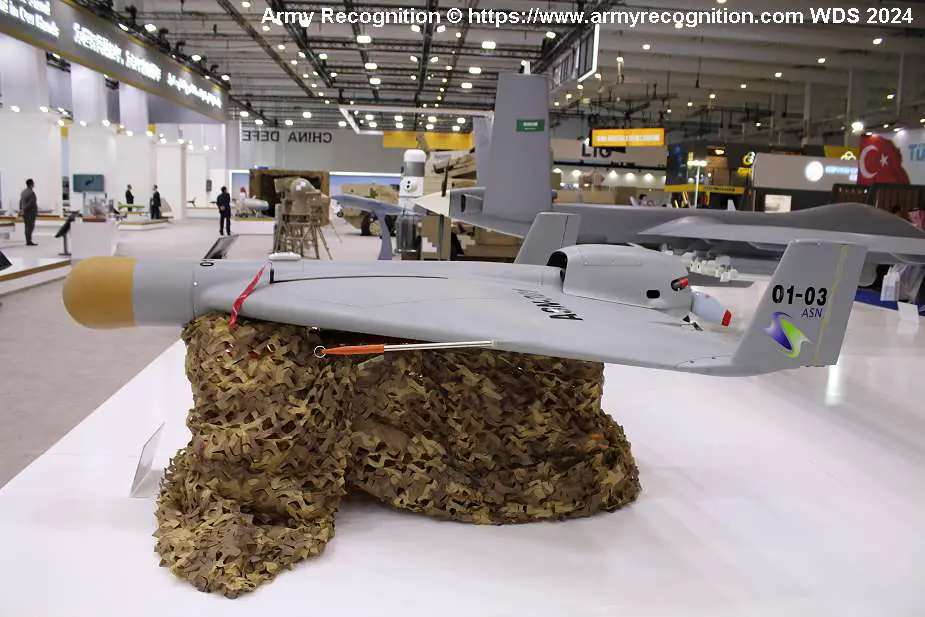Breaking news
China Unveils ASN-301 Loitering Munition Similar to Iranian Shahed-136 and Israeli Harpy.
At the World Defense Show 2024, held in Riyadh, Saudi Arabia from February 4 to 8 2024, China introduced its latest addition to the realm of aerial warfare technology: the ASN-301 loitering munition.
Follow Army Recognition on Google News at this link

The new Chinese ASN-301 loitering munition was unveiled at World Defense Show 2024 in Riyadh, Saudi Arabia. (Picture source Army Recognition Group)
The ASN-301, also referred to as an Unmanned Aerial Vehicle (UAV), is notably reminiscent of the Israel Aerospace Industries (IAI) Harpy system, which was acquired by China in the 1990s. Further comparisons have been drawn to the Iranian Shahed-136, hinting at a shared lineage in design and capabilities. These observations have sparked discussions on the origins of the technology and its implications for global military balance.
Designed as a delta-wing aircraft equipped with a pusher propeller, the ASN-301's architecture mirrors that of the Harpy. Its primary function is to penetrate adversary airspace, loitering until a radar signal is detected. Upon detection, the ASN-301 homes in on the target and executes a precision strike. This capability positions the ASN-301 as a potent tool for neutralizing radar-based defense systems.
Despite its similarities to the Harpy, the ASN-301 boasts distinct specifications. Weighing 135 kg, it is slightly more compact in length at 2.5 meters compared to the Harpy's 2.7 meters. However, it offers an enhanced top speed of 220 km/h against the Harpy's 180 km/h, although it has a reduced operational range of 288 km, compared to the Harpy's 500 km. The ASN-301's endurance is capped at four hours.
Technical insights into the ASN-301 reveal its sophisticated targeting capabilities, with a focus on radar frequencies ranging from 2 to 16 GHz. Its radar homing device can identify targets within a 25 km radius, and the system is programmed to engage up to eight pre-determined radar sites. The munition's warhead, packed with 7,000 fragments, is triggered by a proximity laser fuse, ensuring a lethal radius of 20 meters.
The unveiling of the ASN-301 comes at a time when the development and deployment of loitering munitions have become a focal point in modern warfare strategies worldwide. These systems, often termed as "suicide drones," offer a unique blend of the capabilities found in both traditional missiles and unmanned aerial vehicles. They are designed to linger in an area of interest until a target is located, at which point they can strike with precision.
Globally, the evolution of loitering munitions reflects a shift towards asymmetric warfare tactics, where non-traditional battle methods are leveraged to counter well-entrenched defenses. Countries such as the United States, Israel, Turkey, and Iran have been at the forefront of this technology's development, each producing various systems tailored to specific operational requirements.
For instance, Israel's pioneering work with the Harpy system has influenced numerous defense technology programs worldwide. Similarly, the United States has developed multiple loitering munition systems aimed at enhancing situational awareness and strike capabilities for ground forces. Turkey's Bayraktar TB2 and Kargu drones have seen significant use in various conflicts, showcasing the effectiveness of such systems in modern combat scenarios.
The proliferation of loitering munitions highlights a crucial aspect of contemporary military strategy: the increasing reliance on autonomous and semi-autonomous systems. These technologies offer the promise of reducing risk to human operators while increasing the precision and effectiveness of military operations. However, they also pose ethical and strategic challenges, particularly regarding rules of engagement and the potential for escalation in conflicts.
The unveiling of the ASN-301 at the World Defense Show 2024 not only showcases China's advancing military technology but also underscores the dynamic and evolving nature of global military capabilities. As countries continue to innovate and adapt their military technologies, the implications for international security and defense diplomacy remain a topic of keen interest and debate, reflecting the complex interplay between technological advancement and strategic military objectives.
Defense News February 2024























